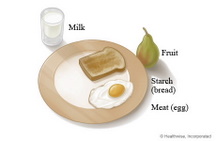A 9" Plate as a Tool for Estimating Carbohydrate
Making the Plate Format Simpler
The standard breakfast in a plate format includes:
• Quarter (1/4) plate bread, grain, or starchy food. Starchy foods include bread, yam, rice, Crix, and other cooked grains; cereal; dasheen; and starchy vegetables, such as sweet potatoes, corn and legumes (cooked dry beans, dry peas and lentils).
• An 8 oz glass of skim or low-fat milk. If you do not like or cannot drink milk, substitute 8 oz of unsweetened (or artificially sweetened) fat-free or low-fat yogurt or calcium-fortified soy milk.
• A serving of fruit. This can be a medium fresh fruit, 1/2 cup cooked or canned fruit, 1/2 cup fruit juice, or 1/4 cup dried fruit.
• An optional one-fourth plate of meat or protein (such as an egg). The American Diabetes Association recommends you eat no more than 3 to 4 egg yolks a week. You may choose to eat fewer egg yolks.

Sample Breakfast Plate
Courtesy Healthwise, Inc.
A standard lunch or dinner in a plate format includes:
• A quarter (1/4) plate starch.
• A quarter plate meat, fish, or poultry.
• A half (1/2) plate non-starchy vegetables.
Non-starchy or low-carbohydrate vegetables include bhagi, green beans, carrots, spinach, tomatoes, cauliflower, sweet peppers, and watercress etc.
• An 8 oz glass of fat-free or low-fat milk.
• A serving of fruit.
This meal plan provides about 40 to 50 grams of carbohydrate at each meal and about 1,200 calories for the day. Most people need more calories than this. For more calories, you can add snacks in the afternoon and at bedtime. Snacks may include 1 or 2 servings of milk, fruit, or starch, depending on your calorie needs.
How to use a plate format
A plate format is so simple that you can start using it right away.
• Post a copy of a sample plate format on your refrigerator. Refer to it until you know how much space different foods should take up on your plate.
• Picture the food on your plate. Learn how much space each food needs on your plate and try to picture that amount when you are in different situations, such as eating out or attending an event.
• Practice. Use a copy of the sample plate format to plan a day's meals and snacks.
• Keep a record. Use a plate format for a week and keep track of your meals and snacks. You can make copies of the sample for each day.
• Check your blood sugar before and 1 hour after you eat, and write the results on your food record.
Information taken and addapted from ADA Journal, WebMD and Domen et al.
 BCDF
BCDF